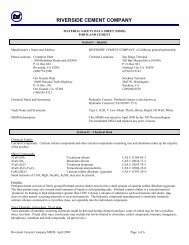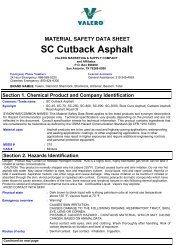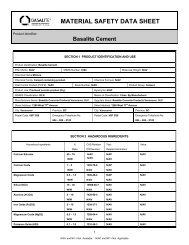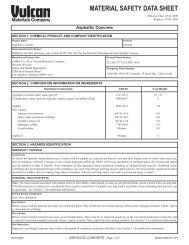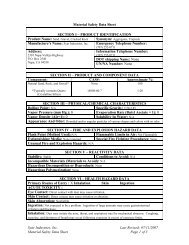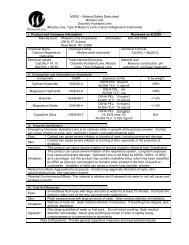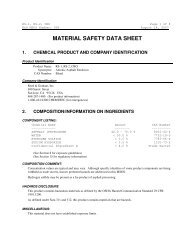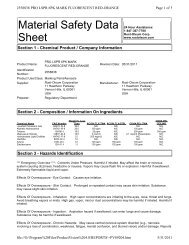MSDS 3239-024-WT (Cold Mix Asphalt Concrete) - CALVAC Paving
MSDS 3239-024-WT (Cold Mix Asphalt Concrete) - CALVAC Paving
MSDS 3239-024-WT (Cold Mix Asphalt Concrete) - CALVAC Paving
- No tags were found...
Create successful ePaper yourself
Turn your PDF publications into a flip-book with our unique Google optimized e-Paper software.
MATERIAL SAFETY DATA SHEET<strong>Cold</strong> <strong>Mix</strong> <strong>Asphalt</strong> <strong>Concrete</strong>SECTION 1. CHEMICAL PRODUCT AND COMPANY IDENTIFICATIONEffective Date: 05/31/2009Replaces: 07/01/2006Product Name:<strong>Cold</strong> <strong>Mix</strong> <strong>Asphalt</strong> <strong>Concrete</strong>Synonyms/Common Names:Temporary <strong>Asphalt</strong> <strong>Concrete</strong>Manufacturer/Contact Info:CalMat Co., d.b.a. Vulcan Materials Company,Western DivisionSafety and Health Department3200 San Fernando RoadLos Angeles, California 90065-1415Formula:<strong>Mix</strong>tureGeneral Phone Number:323-258-2777 (8-5,PST, M-F)Emergency Phone Number:1.866.401.5424 (3E Company, 24 hours/day, 7 days/week)SECTION 2. COMPOSITION INFORMATION ON INGREDIENTSHazardous Components CAS No. % by WeightAggregate (crushed stone, sand, gravel)* <strong>Mix</strong>ture 93*Composition varies naturally-typically contains quartz (crystalline silica) 14808-60-7 >1<strong>Asphalt</strong> 8052-42-4 0.7-7May contain:Vacuum tower bottoms 64741-56-6 >0.1Heavy naph. petroleum distillates 64741-53-3 >0.1Aromatic extract oil 64742-11-6 >0.1Hydrogen sulfide 7783-06-4
POTENTIAL HEALTH EFFECTSInhalation:Emissions from the heated material may have an unpleasant odor and may cause moderate to severe irritation of the mucous membranes and upperrespiratory tract, headaches, nausea and dizziness. Toxic hydrogen sulfide gas may be released. Do not depend upon sense of smell for warning ofoverexposure, since the gas causes rapid olfactory fatigue which deadens the sense of smell at levels as low as 50 ppm. Unconsciousness andasphyxiation may occur in poorly ventilated or confined spaces. See Section 11 for additional information.Ingestion:Direct contact with heated material can cause severe thermal burns. <strong>Asphalt</strong> has a low toxicity when ingested, however, chewing and swallowing asphaltmay cause gastrointestinal effects. Gastric masses (Bezoars) and stomach (pyloric) obstructions have been reported in individuals who have chewed andswallowed asphalt. Aspiration of product into lungs may occur when vomiting, and may result in pulmonary edema and/or chemical pneumonia.Effects Following Prolonged or Repeated Exposure:Prolonged and repeated exposure may cause skin disorders and/or effects on the lung. See Section 11 for additional information.Carcinogenicity:The following components of this product have been listed as carcinogens by the International Agency for Research on Cancer (IARC), the NationalToxicology Program (NTP), or the Occupational Safety and Health Administration (OSHA): crystalline silica-quartz, some petroleum asphalts andheavy naphthenic distillates/aromatic extract oils. See Section 11 for additional information.Signs and Symptoms of Exposure:Repeated or prolonged exposure may cause skin disorders such as dermatitis (reddening, itching, cracking, inflammation), folliculitis, acne-like lesions,bronchitis, pneumonitis (inflammation of the lungs), reduced appetite, abnormal fatigue.Medical Conditions Aggravated by Exposure:Pre-existing medical conditions that may be aggravated by exposure include disorders of the eye, skin and/or lung (including asthma and/or otherbreathing disorders).SECTION 4. FIRST AID MEASURESEyes:Immediately flush eye(s) with plenty of clean water for at least 15 minutes, while holding the eyelid(s) open. Occasionally lift the eyelid(s) to ensurethorough rinsing. Beyond flushing, do not attempt to remove material from the eye(s). Contact a physician if irritation persists or later develops.Thermal burns require immediate medical attention.Skin:Hot Material: Remove contaminated clothing, if possible, and immediately flush skin in cool water for at least 15 minutes. Iced water or cold packsmay be applied to burned area. Do not attempt to remove material from a burn. Get immediate medical attention. <strong>Cold</strong> Material: Clean exposed skinwith soap or mild detergent and large amounts of water until all material is removed from the skin. Do not use solvents or thinners to remove materialfrom skin.Inhalation:Remove person to fresh air. If lung irritation persists or later develops, contact a physician. If not breathing, initiate rescue breathing, give oxygen bytrained personnel and get immediate medical attention. Do not attempt to rescue victim from confined spaces without adequate protective equipment.Ingestion:If swallowed, do not induce vomiting. Drink a large volume of water and get immediate medical attention. Never give anything by mouth to anunconscious person. If vomiting occurs, keep head lower than hips to prevent aspiration.Notes to Physician:In general, emesis induction is unnecessary in high viscosity, low volatility products. Inhalation exposure of hydrogen sulfide may result inpulmonary congestion. Patients may be predisposed to pneumonia during convalescence, and should be kept under observation. Contact a PoisonCenter for additional treatment information.For emergencies, contact 3E Company at 1-866-401-5424 (24 hours/day, 7 days/week)SECTION 5. FIREFIGHTING MEASURESFlash Point (Method Used):Product: Not availableAshalt Cement: >425°F (min). COC<strong>Asphalt</strong> Cutback: > 130°F; Petroleum Distillates: 260°FFlammable Limits:LEL: Product: Not available UEL: Product: Not available<strong>Asphalt</strong> Cement: 0.9 <strong>Asphalt</strong> Cement: 7%Autoignition Temperature:Not availableExtinguishing Media:Agents approved for Class B hazards (e.g., dry chemical, carbon dioxide, halogenated agents, foam, and steam) and water fog. Avoid use of straightstreamwater. Use water spray to keep fire-exposed containers cool. Adding water to hot asphalt presents an explosion hazard.Special Firefighting Procedures:Avoid breathing irritating and potentially toxic fumes, including hydrogen sulfide gas. Firefighters should wear NIOSH/MSHA approved positivepressure breathing apparatus (SCBA) with full face mask and full protective equipment.<strong>MSDS</strong> <strong>3239</strong>-<strong>024</strong>-<strong>WT</strong> COLD MIX ASPHALT CONCRETE - Page 2 of 7 05/31/2009
Unusual Fire and Explosion Hazards:Do not heat above flash point. Fumes/vapors can explode when concentrated in an enclosed environment and supplied with an ignition source. Neverweld or use a cutting torch or open flame on a full, partially full or empty bin, hopper, or other container that holds or has held asphaltic materialunless precautions are taken to prevent explosion. Adding water to hot asphalt presents an explosion hazard.WARNING: Hydrogen sulfide (H 2 S) and other hazardous gases/vapors may evolve and collect in the headspace of storage tanks or other enclosedvessels, and can create an explosive, toxic, or oxygen deficient atmosphere. H 2 S gas is extremely flammable and can explode if an ignition source isprovided. See Sections 3 and 11 for health effects of H 2 S gas.SECTION 6. ACCIDENTAL RELEASE MEASURESPrecautions if Material is Spilled or Released:Ventilate area and avoid emission inhalation or skin contact by using appropriate precautions outlined in this <strong>MSDS</strong> (see Section 8). Keep all sourcesof ignition at least 50 feet away. Prevent materials from entering streams, drainages, or sewers. Spills entering surface waters or sewersentering/leading to surface waters must be reported to the National Response Center 1-800-424-8802. Based on volume and use, components of thisproduct may be subject to reporting requirements of Title III of SARA, 1986, and 40 CFR 372.For emergencies, contact 3E Company at 1-866-401-5424 (24 hours/day, 7 days/week).Waste Disposal Methods:Contact the asphalt plant to determine feasibility of recycling material. Dispose of waste materials in accordance with applicable federal, state andlocal laws and regulations.Environmental Precautions:Stop leak and contain spilled material with sand, aggregate fines, or other inert adsorbent. Collect adsorbed product and clean up materials inappropriate container for proper disposal. Notify proper authorities.SECTION 7. HANDLING AND STORAGEStorage:Store away from all ignition sources and open flames in accordance with applicable laws and regulations.Vapors containing hydrogen sulfide may accumulate during storage or transport of asphaltic materials. When petroleum asphalt products are heated,potentially irritating emissions (fumes, mists, vapors) may be released.Handling:Follow personal protection and protective controls set forth in Section 8 of this <strong>MSDS</strong> when handling this product. If personnel must enter a tank orother confined space that contained this material, follow the OSHA Confined Space Entry Program as specified in 29 CFR 1910.146. Do not storenear food, beverages or smoking materials. Avoid personal contact with heated material. Respirable crystalline silica-containing dust may begenerated when hardened asphalt concrete is subjected to mechanical forces, such as demolition work, surface treatment (sanding, grooving,chiseling, etc.), and/or recycling of pavement.Do not attempt to clean empty containers since residue is difficult to remove. Do not pressurize, cut, weld, braze, solder, drill, grind or expose suchcontainers to heat, flame, sparks, static electricity, or other sources of ignition as they may explode and cause injury or death.Tripping accidents have occurred because of asphalt buildup on bottoms of shoes and boots; buildup should be removed regularly to prevent suchaccidents. Do not use solvents or thinners to clean footwear.SECTION 8. EXPOSURE CONTROLS AND PERSONAL PROTECTIONLegend:NE = Not Established; PEL = Permissible Exposure Limit; TLV = Threshold Limit Value; REL = Recommended Exposure Limit; OSHA = Occupational Safety and HealthAdministration; MSHA = Mine Safety and Health Administration; NIOSH = National Institute for Occupational Safety and Health; ACGIH = American Conference ofGovernmental Industrial HygienistsComponent<strong>Asphalt</strong> FumesParticulates not otherwise classifiedRespirable dust containing silicaTotal dust containing silicaRespirable Crystalline Silica (quartz)Respirable Tridymite and Cristobalite (otherforms of crystalline silica)NEOSHA/MSHAPEL15 mg/m 3 (total dust)5 mg/m 3 (respirable fraction)10 mg/m 3 ÷ (% silica + 2)OSHA: 30 mg/m 3 ÷ (% silica + 2)MSHA: 30 mg/m 3 ÷ (% silica + 3)NE - Use respirable dustcontaining silica PEL½ of OSHA and MSHA respirabledust containing silica PELACGIHNIOSHTLVREL0.5 mg/m 3 (as benzene-soluble REL-Ceiling 5 ppmaerosol)10 mg/m 3 (inhalable fraction) NE3 mg/m 3 (respirable fraction)Use Respirable Silica TLVUse Respirable Silica TLVNENE0.05 mg/m 30.025 mg/m 30.05 mg/m 30.025 mg/m 305/31/2009 COLD MIX ASPHALT CONCRETE - Page 3 of 7 <strong>MSDS</strong> <strong>3239</strong>-<strong>024</strong>-<strong>WT</strong>
Legend:NE = Not Established; PEL = Permissible Exposure Limit; TLV = Threshold Limit Value; REL = Recommended Exposure Limit; OSHA = Occupational Safety and HealthAdministration; MSHA = Mine Safety and Health Administration; NIOSH = National Institute for Occupational Safety and Health; ACGIH = American Conference ofGovernmental Industrial HygienistsComponentOSHA/MSHAPELACGIHTLVNIOSHRELAmmonia (NH 3 )PEL 50 ppmTLV 25 ppmTLV-STEL 35 ppmREL 25 ppmREL-Ceiling 35 ppmCarbon Monoxide (CO)PEL 50 ppm25 ppmREL 35 ppmREL-Ceiling 200 ppmHydrogen Sulfide (H 2 S)PEL-Ceiling 20 ppmTLV 10 ppmTLV-STEL 15 ppmREL-Ceiling 10 ppmNitrogen Dioxide (NO 2 )PEL-Ceiling 5 ppmTLV 3 ppmTLV-STEL 5 ppmREL-STEL 1 ppmOzone (O 3 )PEL 0.1 ppm0.05 ppmREL-Ceiling 0.1 ppmSulfur Dioxide (SO 2 )PEL 5 ppmTLV-STEL 0.25 ppmREL 2 ppmREL-STEL 5 ppmEye Protection:Use a full-face shield and chemical safety goggles if handling heated material. Safety glasses with side shields should be worn as minimum protectionat ambient temperatures. Contact lens should not be worn when eye contact with product is possible.Skin Protection (Protective Gloves/Clothing):Avoid skin contact with material by wearing impervious gloves and protective clothing. With product at ambient temperatures, use disposable nitrile,neoprene or butyl rubber material. When handling hot material, use heat-resistant gloves. Use insulated, heat-resistant clothing as necessary.Respiratory Protection:Not expected to be necessary under normal use and working conditions. All respirators must be NIOSH-approved for the exposure levels present.(See NIOSH Respirator Selection Guide). The need for respiratory protection should be evaluated by a qualified safety and health professional. Forair-contaminant concentrations which exceed or are likely to exceed applicable exposure limits, use a NIOSH-approved, contaminant-specific, airpurifyingrespirator. If such conditions are sufficiently high that the air-purifying respirator is inadequate, or if oxygen adequate to sustain life is notpresent, use a positive-pressure, self-contained breathing apparatus. Activities that generate dust require the use of an appropriate dust respiratorwhere dust levels exceed or are likely to exceed allowable exposure limits. For respirable silica levels that exceed or are likely to exceed an 8-hourTime Weighted Average (TWA) of 0.5 mg/m 3 , a high-efficiency particulate filter respirator must be worn at a minimum; however, if respirable silicalevels exceed or are likely to exceed an 8-hour TWA of 5.0 mg/m 3 a positive-pressure, full-face respirator or equivalent is required. Respirator usemust comply with applicable MSHA (42 CFR 84) or OSHA (29 CFR 1910.134) standards, which include provisions for a user training program,respirator inspection, repair and cleaning, respirator fit testing, medical surveillance and other requirements.Engineering Controls:General dilution or local exhaust ventilation as required to maintain exposures below appropriate exposure limits. Use only in well-ventilated areas.Activities with dried/hardened product that generate dust require the use of general ventilation, local exhaust and/or wet suppression methods tomaintain exposures below appropriate exposure limits.Other:Workers should station themselves on the upwind side of asphalt emissions when possible. It is recommended that asphalt emissions be monitoredregularly to determine exposure levels. Respirable dust and quartz levels should be monitored regularly to determine worker exposure levels.Exposure levels in excess of appropriate exposure limits must be reduced by all feasible engineering controls, including (but not limited to),ventilation, process enclosure, and/or enclosed employee workstations.Wash hands before eating, drinking, smoking, and/or using toilet facilities. A clean water supply for emergency first aid and washing facilities shouldbe readily available. Do not use solvents or thinners to remove material from skin. Laundering clothing between uses is recommended.SECTION 9. PHYSICAL AND CHEMICAL PROPERTIESBoiling Point:Not availableEvaporation Rate (Butyl Acetate = 1):Not availableSolubility in Water:NegligibleAppearance and Odor:Black, viscous, granular. Petroleum odor.pH:Not applicableMelting Point:Not availableVapor Density (Air = 1):>1Specific Gravity (H 2 O = 1):2.0 - 2.5Vapor Pressure (mm Hg.):Not available% Volatile:
SECTION 10. STABILITY AND REACTIVITYStability:Stable under normal temperatures and pressures.Conditions to Avoid:Keep away from direct flame/ignition sources. Contact with incompatible materials should be avoided (see below). See Sections 5, 6 and 7 foradditional information.Incompatibility (Materials to Avoid):Strong oxidizers may react with hydrocarbons. Contact with fluorine may cause burning or explosion. Adding water to hot asphalt presents anexplosion hazard.Hazardous Decomposition or Byproducts:Carbon monoxide and other compounds (such as amines, ammonia, nitrogen dioxide, sulfur dioxide, ozone, hydrogen sulfide, and varioushydrocarbons) may be released by thermal decomposition. Hazardous vapors can collect in enclosed vessels or areas if not properly ventilated. Ifhydrogen sulfide is present, the flammable limits range from 4.3 to 45.5% by volume and its presence may promote the formation of pyrophoric(spontaneously igniting) iron compounds (See 29 CFR 1910.146). Silica-containing respirable dust particles can be generated. When heated, quartzis slowly transformed into tridymite (above 860˚C/1580˚F) and cristobalite (above 1470˚C/2678˚F). Both tridymite and cristobalite are other formsof crystalline silica and are considered more fibrogenic to the lungs than quartz.Hazardous Polymerization:Not known to occur.SECTION 11. TOXICOLOGICAL INFORMATIONAcute Effects:<strong>Asphalt</strong> has oral LD50 (rats) >5g/kg.Petroleum-derived asphalt products should not be confused with “tar” products, which are produced from the destructive distillation of coal. Thehydrocarbons in petroleum asphalt are a complex mixture of paraffinic, naphthenic, and aromatic hydrocarbons, including polycyclic aromaticcompounds.Contains or may release hydrogen sulfide (H 2 S) gas. Exposure to H 2 S concentrations above the permissible exposure limit causes irritation of themucous membranes, headache, dizziness, vomiting, coughing, nasal discharge and pulmonary edema. At levels between 500 and 700 ppm,respiratory paralysis, loss of consciousness and possibly death can occur within 30 to 60 minutes. Exposure to higher concentrations can result inimmediate death. Repeated exposure to low levels may also cause eye effects including conjunctivitis and corneal injury. There is no evidence thatH 2 S will accumulate in the body tissue after repeated overexposure.Effects Following Prolonged or Repeated Exposure:Prolonged and repeated exposure to asphalt may cause skin disorders such as dermatitis, folliculitis, and acne-like lesions, or more rarely,pigmentation of the skin. Chronic inhalation of high concentrations of asphalt emissions may cause chronic bronchitis and pneumonitis(inflammation of the lungs). In mice, there was damage to the lungs, including bronchitis, pneumonitis, and abscess formation. Guinea pigs and ratsshowed pneumonitis, peribronchial adenomatosis, and some squamous cell metaplasia.This material contains heavy vacuum distillates/aromatic extract oils. Repeated dermal application of these oils to experimental animals has beenreported to cause skin disorders, effects on the liver, thymus and blood forming organs, as well as fetal death and birth defects.Repeated exposure to low levels of H 2 S may cause eye effects including conjunctivitis and corneal injury. There is no evidence that H 2 S willaccumulate in the body tissue.The following information applies to the dried product if it is subjected to mechanical forces (such as demolition or asphalt recycling work),which may generate crystalline silica-containing dust particles:Prolonged overexposure to respirable dusts in excess of appropriate exposure limits can cause inflammation of the lung leading to possible fibroticchanges, a medical condition known as pneumoconiosis.Prolonged and repeated inhalation of respirable crystalline silica-containing dust in excess of allowable exposure limits may cause a chronic form ofsilicosis, an incurable lung disease that may result in permanent lung damage or death. Chronic silicosis generally occurs after 10 years or more ofoverexposure; a more accelerated type of silicosis may occur between 5 and 10 years of higher levels of exposure. In early stages of silicosis, not allindividuals will exhibit symptoms (signs) of the disease. However, silicosis can be progressive, and symptoms can appear at any time, even yearsafter exposure has ceased. Symptoms of silicosis may include, but are not limited to, the following: shortness of breath; difficulty breathing with orwithout exertion; coughing; diminished work capacity; diminished chest expansion; reduction of lung volume; right heart enlargement and/or failure.Persons with silicosis have an increased risk of pulmonary tuberculosis infection.Repeated overexposures to very high levels of respirable crystalline silica (quartz, cristobalite, tridymite) for periods as short as six months may causeacute silicosis. Acute silicosis is a rapidly progressive, incurable lung disease that is typically fatal. Symptoms include, but are not limited to,shortness of breath, cough, fever, weight loss, and chest pain.Respirable dust containing newly broken silica particles has been shown to be more hazardous to animals in laboratory tests than respirable dustcontaining older silica particles of similar size. Respirable silica particles which had aged for sixty days or more showed less lung injury in animalsthan equal exposures of respirable dust containing newly broken particles of silica.There are reports in the literature suggesting that excessive crystalline silica exposure may be associated with autoimmune disorders and otheradverse health effects involving the kidney. In particular, the incidence of scleroderma (thickening of the skin caused by swelling and thickening offibrous tissue) appears to be higher in silicotic individuals. To date, the evidence does not conclusively determine a causal relationship between silicaexposure and these adverse health effects.05/31/2009 COLD MIX ASPHALT CONCRETE - Page 5 of 7 <strong>MSDS</strong> <strong>3239</strong>-<strong>024</strong>-<strong>WT</strong>
Carcinogenicity:Skin application of asphalt fume condensate fractions caused skin tumors in laboratory mice. When asphalt was dissolved or mixed with a solventprior to exposing laboratory animals, the carcinogenicity results were weakly positive. The causal agent is thought to be 4 to 6 ring polycyclicaromatic compounds (PAH). Trace amounts of these materials may be present in asphalts and can be generated upon excessive heating. Some PAHshave been identified as causing carcinogenic and reproductive effects. Currently, epidemiological evidence does not support a link between asphaltexposure and human skin cancer.Repeated breathing of asphalt emissions has not resulted in a carcinogenic response in laboratory animal testing. Although epidemiological studieson asphalt workers have suggested a possible link between asphalt fumes and certain types of cancer, confounding factors such as smoking andconcomitant exposure to other agents in the workplace may have influenced the results of these studies. <strong>Asphalt</strong> is not listed as a carcinogen by theNational Toxicology Program (NTP) or the Occupational Safety and Health Administration (OSHA). In 1985, the International Agency for Researchon Cancer (IARC) determined that there is inadequate evidence that asphalt alone is carcinogenic to humans. However, IARC states that there issufficient evidence that extracts (asphalts dissolved in hydrocarbon solvents) are carcinogenic to laboratory animals. Although epidemiologicalstudies on some petroleum products containing polycyclic aromatics suggest the possibility of skin cancer induction in humans, a link betweenpetroleum asphalt exposure and human skin cancer has not been established.This material contains heavy vacuum distillates/aromatic extract oils. IARC has determined that there is sufficient evidence in experimental animalsfor their carcinogenicity, and has classified these oils as Group 1, or human carcinogens.The following information applies to the dried product if it is subjected to mechanical forces (such as demolition or asphalt recycling work),which may generate crystalline silica-containing dust particles:Epidemiology studies on the association between crystalline silica exposure and lung cancer have had both positive and negative results. There issome speculation that the source and type of crystalline silica may play a role. Studies of persons with silicosis indicate an increased risk ofdeveloping lung cancer, a risk that increases with the level and duration of exposure. It is not clear whether or not lung cancer develops in nonsilicoticpatients. Several studies of silicotics do not account for lung cancer confounders, especially smoking, which have been shown to increasethe risk of developing lung disorders, including emphysema and lung cancer.In October 1996, an IARC Working Group designated respirable crystalline silica as carcinogenic (Group 1). The NTP's Report on Carcinogens, 9thedition, lists respirable crystalline silica as a “known human carcinogen.” In the year 2000, the American Conference of Governmental IndustrialHygienists (ACGIH) listed respirable crystalline silica (quartz) as a suspected human carcinogen (A-2). These classifications are based on sufficientevidence of carcinogenicity in certain experimental animals and on selected epidemiological studies of workers exposed to crystalline silica.SECTION 12. ECOLOGICAL INFORMATIONAquatic Ecotoxicological Data:No specific data on this product. The asphalt component may cause damage to aquatic organisms.Environmental Fate Data:Significant migration into the environment and bioaccumulation are unlikely. Expected to be resistant to biodegradation.Other:No specific data on this product.SECTION 13. DISPOSAL CONSIDERATIONSPlace contaminated materials in appropriate containers and dispose of in a manner consistent with applicable federal, state, and local regulations.Prevent from entering drainage, sewer systems, and unintended bodies of water. It is the responsibility of the user to determine, at the time ofdisposal, whether product meets criteria for hazardous waste. Product uses, transformations, mixture and processes, may render the resulting materialhazardous.SECTION 14. TRANSPORT INFORMATION [Note: Not intended to be all-inclusive.]DOT Proper Shipping Name:Not regulated.UN/NA Number:Not regulated.DOT Hazard Classification:Not applicable.DOT Packing Group:Not applicable.Labeling Requirements:If the shipping temperature of a solid equals or exceeds 464˚F, DOT regulation classifies the solid as an “Elevated Temperature Material”, and a “HOT”label is required. Label as required by the OSHA Hazard Communication standard [29 CFR 1910.1200(f)], and applicable state and local regulations.SECTION 15. REGULATORY INFORMATION [Note: Not intended to be all-inclusive.]Toxic Substances Control Act (TSCA):The components in this product are listed on the TSCA Inventory or are exempt.Comprehensive Environmental Response, Compensation and Liability Act (CERCLA):Releases of this material to water may be reportable to the National Response Center under the Comprehensive Environmental Response,Compensation, and Liability Act (CERCLA) or to state and local emergency planning committees under the Superfund Amendments andReauthorization Act. It is recommended that you contact state and local authorities to determine if there are any local reporting requirements in theevent of a spill.<strong>MSDS</strong> <strong>3239</strong>-<strong>024</strong>-<strong>WT</strong> COLD MIX ASPHALT CONCRETE - Page 6 of 7 05/31/2009
Superfund Amendments and Reauthorization Act of 1986 (SARA), Title III:Section 302 extremely hazardous substances:NoneSection 311/312 hazard categories:Immediate HealthDelayed HealthSection 313 reportable ingredients at or above de minimus concentrations:NoneCalifornia Proposition 65:WARNING: THIS PRODUCT CONTAINS CHEMICALS (CRYSTALLINE SILICA, BITUMENS, VARIOUS AROMATIC HYDROCARBONS)KNOWN TO THE STATE OF CALIFORNIA TO CAUSE CANCER AND BIRTH DEFECTS OR OTHER REPRODUCTIVE HARM.State Regulatory Lists:Each state may promulgate standards more stringent than the federal government. This section cannot encompass an inclusive list orall state regulations. Therefore, the user should review the components listed in Section 2 and consult state or local authorities forspecific regulations that apply.SECTION 16. OTHER INFORMATIONDisclaimer of LiabilityVulcan Materials Company believes the information contained herein is accurate, however, Vulcan Materials Company makes no guarantees withrespect to such accuracy and assumes no liability in connection with the use of the information contained herein by any party. The provision ofthe information contained herein is not intended to be and should not be construed as legal advice or as ensuring compliance with and federal,state, or local laws and regulations. Any party using this product should review all such laws, rules or regulations prior to use.NO WARRANTY IS MADE, EXPRESS OR IMPLIED, OF MERCHANTABILITY, FITNESS FOR A PARTICULARPURPOSE OR OTHERWISE.05/31/2009 COLD MIX ASPHALT CONCRETE - Page 7 of 7 <strong>MSDS</strong> <strong>3239</strong>-<strong>024</strong>-<strong>WT</strong>
CalMat Co., d.b.a. Vulcan Materials Company,Western DivisionSafety and Health Department3200 San Fernando RoadLos Angeles, CA 90065-1415<strong>MSDS</strong> <strong>3239</strong>-<strong>024</strong>-<strong>WT</strong>Dear Customer/Contractor:Please find attached a material safety data sheet (<strong>MSDS</strong>) for the product that youpurchased from Vulcan Materials Company. This is a revised <strong>MSDS</strong> and replacesany previous versions of the <strong>MSDS</strong> for this product. This <strong>MSDS</strong> is provided to youas required by the Occupational Safety and Health Administration's (OSHA)Hazard Communication Standard (29 CFR 1910.1200), the Mine Safety andHealth Administration's (MSHA) Hazard Communication Standard (30 CFR Part47), and/or any applicable state Right-to-Know laws.It is the responsibility of your company to communicate this information to youremployees, customers, and contractors who may use or come in contact with thisproduct. Further, if you distribute this product, Vulcan Materials Companyrequests, and applicable laws may require, that you forward this <strong>MSDS</strong> to yourcustomers.Please direct this information to the person responsible for safety and healthcompliance at your company. If you have questions about the <strong>MSDS</strong>, pleasecontact Vulcan Materials Company at the address and phone number listed onpage one of the <strong>MSDS</strong>.If you need additional copies of this or any other Vulcan Materials Company<strong>MSDS</strong> or a Spanish language version, you can obtain them atwww.vulcanmaterials.com or by calling 1-866-401-5424.La <strong>MSDS</strong> puede obtenerse en www.vulcanmaterials.com o llamando al 1-866-401-5424.Sincerely,Kelly F. Bailey, C.I.H.Corporate Director,Industrial Hygiene and Health ServicesP.O. BOX 385014 • BIRMINGHAM, ALABAMA 35238-5014



